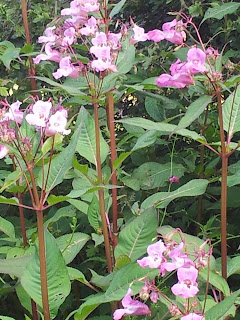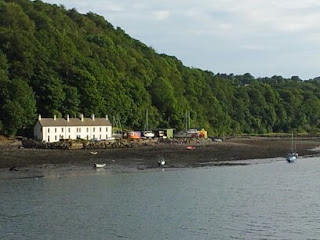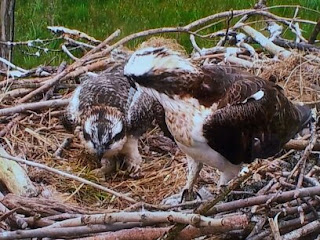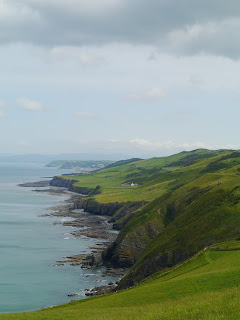Around the edge of
Wales (23)……Nefyn to Bangor
The last leg of the journey. So difficult to believe that it
all ends today and to imagine myself back in the office tomorrow, sitting
behind a desk and staring at a screen all day.
But there’s plenty to look forward to today, on this final
stretch. Although the forecast sounded promising it doesn’t look too bright in
Nefyn. The path leads around the back of the village towards the quarries south
of the B4417 – quite a distance from the coast.
It wasn’t an enjoyable start to the day. Swathes of
Himalayan balsam filled the stream alongside the path out of the village – it's been particularly noticeable this year. This
invasive plant, introduced to Victorian gardens, is sprinting along banks
of streams and rivers everywhere and is easy to identify in summer when the sickly scent
of the pink and white slipper-like flowers fill the air.
Further on along the path the summer growth was dense and
wet – no scythe or strimmer had passed this way in months. There was no
avoiding wet legs and soaking feet. Cursing the local authority I decided to
come down from the mountainside and return to the road. It was a relief to walk
on tarmac for half an hour, before reconnecting with the path at Pistyll and
heading back down towards the cliffs.
But here again the silage fields were sheets of wet, flopped
grass. I had no hope of keeping my feet dry along this section either so I decided to
paddle barefoot for a while through the mushy ryegrass. The puddled, silky soil
squidged under my feet with every step, seeping between my toes. The ruined
hotel on the clifftop at Pistyll was as grim as ever. A dark hulk of a skeleton
– forbidding and very unloved. I wondered what its origins were and how its
fortune, and then misfortune, had unfolded as I picked my way carefully through
a herd of sullen cattle and cow pats, with one very nervous dog at my side.
Pistyll church is a lovely place to visit at any time, but especially
in summer when parishioners spread grass and wildflowers on the floor. The
smell of dry, mown hay seems to wrap itself around you as you enter. I spent some time in the
church and graveyard looking for interesting carvings on the headstones before heading off towards
Craig y Nant headland. Plenty of walls and scree slopes along this section and
it was no surprise to see so many wheatears. Another three choughs called above
my head.
From Craig y Nant I decided to descend the steep slope to the
long stony beach of Porth y Nant. My heart jumped when I spotted what I thought was a line of dead moles strung
above the beach – only to find as I got closer that they were a string of lone
trainers, dangling sadly. Rescued but unclaimed spoils of the sea!
I stopped at Nant Gwrtheyrn for a sandwich at Caffi Meinir. Nant
Gwrtheyrn is well worth visiting, between the houses that have been beautifully
restored, the excellent café and the interesting interpretation that reveals so
much about the history of the village and its community.
At last it was getting warmer, but escaping from the Nant meant a
long, steep climb to the path that leads across the flanks of the Eifl. Through
a small conifer plantation, to start, with goldcrests and long tailed tits
chirping and flitting between branches. A sparrowhawk glided silently beneath
the dark canopy, though the thin mist that rose from the steaming earth. In the
distance a narrow skein of a waterfall pounded over the edge of the cliff below the
summit of Yr Eifl, slicing the air in a sheer vertical descent. I chatted for a
while with a couple who had just started to walk down to the village but were
just beginning to reassess their plans as the reality of the return journey
dawned on them.
The path across the Eifl is an easy stone track through heather.
In no time at all I’d reached the abandoned granite quarries of Trefor. There
was no one else in this eerie, dramatic and boulder-ridden place where slopes and
cliff faces have been hewn over centuries and where deserted buildings seem to
cling to rock edges like left over parts of a film set. Everywhere was silent.
Not a single bird had chosen to nest in the folorn man-made structures, but the
views down towards Trefor, over to Gyrn Goch, Gyrn Ddu and Clynnog were amazing
– as well as the view down to Moel y Gest near Porthmadog. I was glad though to
come across the path that led me steeply down an incline to Trefor village, past
meadows where a tiny tractor purred in the late sun, with a chorus of noisy
gulls following in its wake.
Out again to the coast, through Moelfre farm which is now owned by
the National Trust. A popular stretch of coast where a good numbermore people were walking and
some even running across the soft grassy clifftop.
I quickly reached the attractive harbour at the edge of Trefor and sat down
for five minutes to study the map again to see if I could follow the line of
the coast to Pontllyfni and Dinas Dinlle.
No such luck. From here the coast path follows the cycle track
along the new road that flies past Clynnog. I decided to phone home and ask if
I could have the Airnimal bike back for this final leg – especially as it was
now 5pm! I’d lost hours struggling through the wet early-morning vegetation,
chatting at Pistyll church and taking photos around Nant Gwrtheyrn.
The bike ride was brilliant – a good track all the way to
Glynllifon, along the old road through Clynnog village, then down to Llandwrog
and Dinas Dinlle before turning back to join the beautiful road that skirts the
edge of the Foryd estuary towards Caernarfon. The estuary was mesmerising in
the evening sun and the Anglesey coast seemed to be within touching distance.
I rounded into Caernarfon from the edge of the Menai straits – my
favourite view of the town, a mix of old elegant terraces, harbour and castle.
Skimmed the pavements through town then out to Felinheli where the smell of
food from the open windows of the Gardd Fôn, down on the front, was almost too
tempting. I pressed on though, determined to finish the journey that evening,
and quickly joined Lôn Adda, the new cycle route through Bangor. The sky was
still a brilliant blue in Port Penrhyn. I found that the old Dickies boatyard
had been erased and the site scalped to
soil – a massive board advertised the imminent arrival of new flats and I
sensed that the place was about to be blotted by another monstrosity to rival
the Victoria dock development in Caernarfon
A quick ride over to the gates of Penrhyn Castle, so that I could
at least say that I’d ended the journey exactly where I’d started, then back to
Bangor Pier for a final walk over the boards. At 9pm the sun was sweeping over
the Carneddau mountains to the east, and gilding the Straits and its woodland
edges towards the west. Stunning.
But the following morning I would have started over again. One of
the best, most memorable journeys ever.
Home - at the end of the journey





















































